Author: Kellie Hayden
Updated: March 4, 2024
While guinea pig pet parents may know that hay is important for their small herbivore’s diet, they may not know what types of hay are ideal for their pet. In this article, we’ll cover what the best types of hay are for guinea pigs.
Why Is Hay Important For Guinea Pigs?
Small herbivorous mammals such as guinea pigs are avid eaters! High-fiber diets are especially important for guinea pigs, as they have GI systems that require constant fibrous input in the form of plant material. For this reason, grass hays should be offered in unlimited amounts to small herbivores. Frequently offering your guinea pig grass hay throughout the day keeps them interested in eating and provides abundant plant material to eat, keeping their GI system moving at a healthy pace.
While the wild ancestors of guinea pigs often had to juggle the two tasks of finding enough to eat and hiding from predators, our small companions who are safe indoors no longer need to eat as much food as possible while they avoid becoming a meal for another animal. This is another reason why grass hays are the basis of small herbivore diets: it keeps their GI systems properly functioning while not being so calorically dense that it causes major weight gain.
In addition to hay’s nutritional significance, grass hay plays a major role in keeping small herbivores’ dentition (teeth) healthy. Our small herbivores’ teeth have evolved to handle the constant chewing motion of eating fibrous plant material. This means that your guinea pig’s teeth constantly grow as a way to compensate for the heavy wear their dentition experiences while eating large amounts of hay. In a domestic setting, hay helps prevent your little one’s teeth from overgrowing and causing serious issues like tongue entrapment or malocclusion (misalignment) of the teeth.
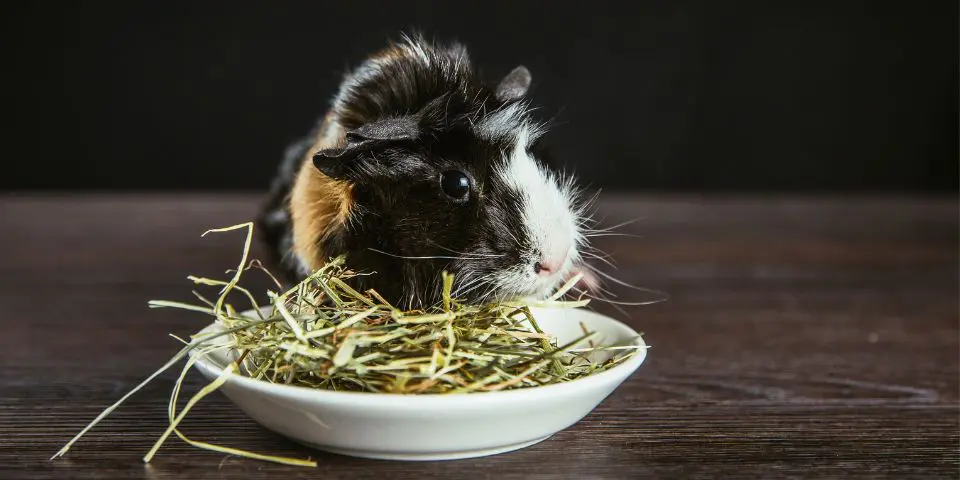
The Importance of Hay Variety
Just like humans, guinea pigs can grow tired of eating the same kind of food day after day. This can lead to undesirable behaviors like picky eating, but can also result in your little one becoming bored. That’s why we highly recommend offering your guinea pig a regular variety of hays. By changing up hay offerings in healthy ways, you are offering new, safe and mentally enriching scenarios for your little to investigate. For some ideas on hay varieties and mixes to offer, check out our blog on ways to feed a variety of hays.
When offering a new hay variety, it can be helpful to mix the new hay with a hay that your guinea pig is used to. Keep in mind that guinea pigs are a prey species; they are hardwired to perceive changes in their environment as a way to assess whether something may or may not be a threat. If you change an element of their surroundings too quickly, this can act as a red flag that something is wrong to an especially perceptive and cautious piggy. Mixing hays can help keep your pet from turning their nose up at new offerings and refusing to eat hay—which, as we discussed earlier, can create serious health concerns for their digestive tract.
What are the Best Types of Hay For Guinea Pigs?
Now that we know about the importance of hay in your guinea pig’s diet, let’s answer: what is the best hay for your guinea pig? There are short and long answers!
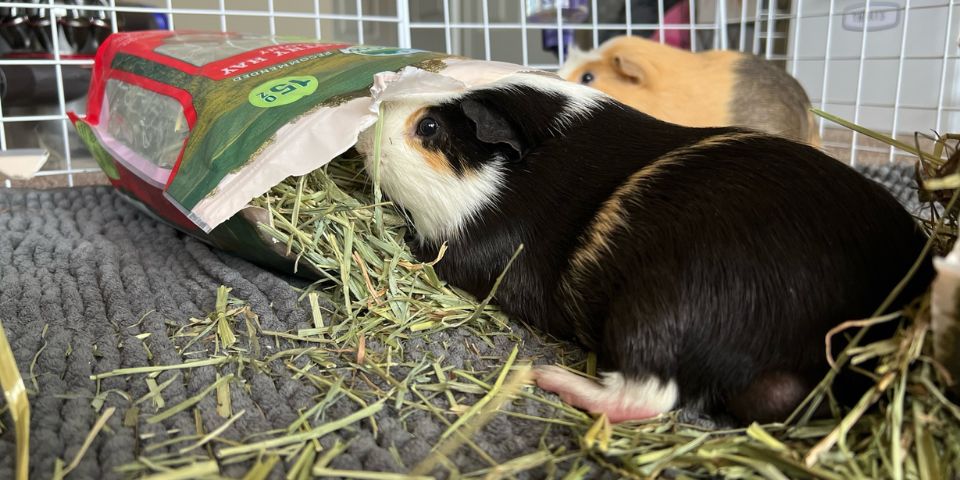
Western Timothy Hay
Many pet parents of small herbivores know about Western Timothy Hay, but for those who may not, Western Timothy Hay is considered the “staple” grass hay for small herbivores like guinea pigs, rabbits, and chinchillas. This hay is an optimal high-fiber forage.
What makes Western Timothy Hay so ideal for adult guinea pigs in particular is that it’s a grass hay. Grass hays do not contain excess amounts of calories or energy in comparison to legume hays like alfalfa, so it can be provided in the ample amounts necessary to keep our little ones’ GI systems healthy. Many pets particularly enjoy that Western Timothy Hay contains the perfect balance of stems, leaves, and seed heads, allowing for some texture enrichment while still being nutritionally correct for small herbivores.
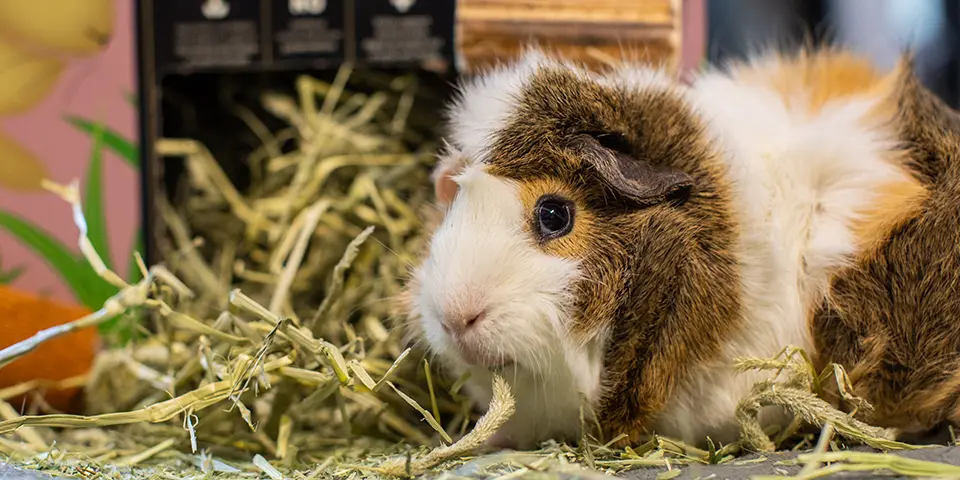
Prime Cut Hays: A Premium Experience
If you find that your guinea pig is consistently a picky eater when it comes to the type of hay cutting they enjoy, we highly recommend trying our Prime Cut Hays. We offer two cuttings of Western Timothy Hay based on two popular taste and texture preferences: Hearty and Crunchy and Soft and Lush.
Hay Blends
Hay Blends is simply the best of both worlds! Consisting of a 50/50 blend of Western Timothy Hay and Orchard Grass, this hay can serve as either a great daily forage, or as a great transition hay if you’re moving your pet from Western Timothy Hay to Orchard Grass (or vice versa). If you find your guinea pig is becoming pickier with their daily forage, this hay may help them snap out of their picky behavior before it becomes more difficult to correct.
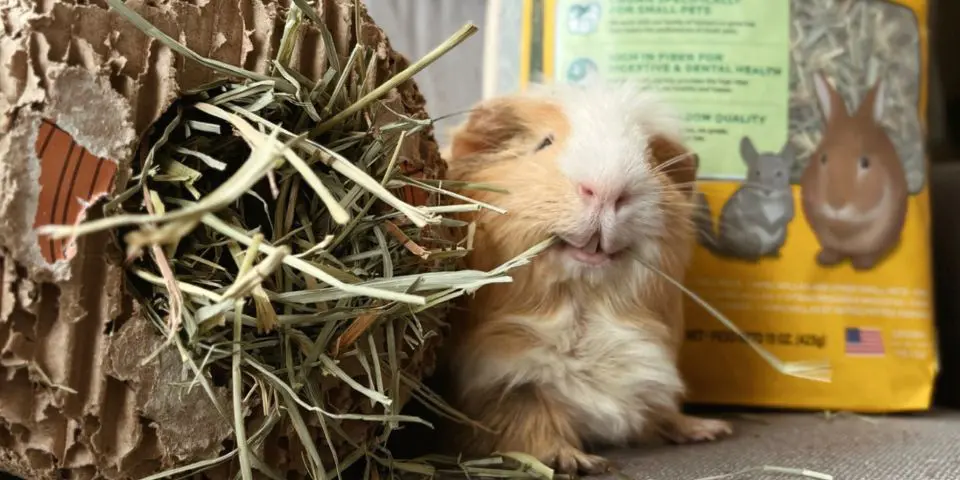
Orchard Grass
Orchard Grass, similar to Western Timothy Hay, can be considered another type of hay that guinea pigs can consume in unlimited amounts. Some pet parents find that their guinea pig may prefer orchard grass if their little one is especially particular to eating the leafy parts of hay, leaving the seed heads or stems behind.
If your guinea pig loves to relax within or on top of a pile of hay, orchard grass may also be a winner. Orchard grass tends to have a softer texture than Western Timothy Hay, and some pets may find it especially enticing as a bed for rest and relaxation!
Orchard Grass not only benefits pets. Some pet parents who have hay allergies may find that they have a less severe reaction to Orchard Grass than they do to Western Timothy Hay when handling these respective forages. If you have a known allergy to Western Timothy Hay, it may be time to try Orchard Grass. However, if you have severe reactions such as hives or throat tightness to many materials, always discuss trying new forages with your doctor first!
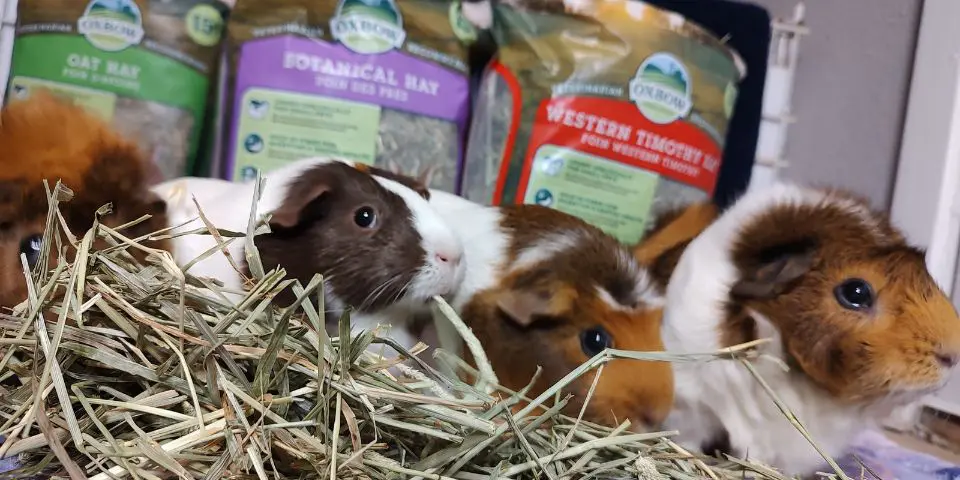
Botanical Hay
Oxbow’s Botanical Hay is essentially Western Timothy Hay with a twist! While it mostly consists of our favorite high-fiber forage, it also contains safe-to-ingest aromatics like chamomile, lavender, clover, and lemon balm. We recommend that pet parents keep a bag or two of this hay in their enrichment and first aid arsenals.
While it can be a fun hay to offer as a yummy surprise, botanical hay can also be kept on-hand in case your pet ever exhibits signs of pickiness or boredom with their regular hay. If your pet is leaving more and more hay behind by the time they start begging for a new pile of forage, now might be the time to change things up. Try mixing Botanical Hay in with the clean, unsoiled hay already in your guinea pig’s habitat to encourage your piggy to eat more of what they already have.
Botanical hay can also be kept in a first aid kit. Botanical aromatics may entice a little one who is not feeling well to eat on their own. If your guinea pig is not eating anything on their own, please contact your veterinarian right away, as this is a symptom of a serious and painful condition called Gastrointestinal Stasis.
Alfalfa Hay
Alfalfa hay is what we call a legume hay and is a member of the sweetpea family. Unlike the four hays mentioned above, alfalfa is more calorically dense. It is the ideal forage to provide the additional nutrition and energy necessary for guinea pigs that are in the infant and young (0 – 6 months old) life stages, as well as to pregnant or nursing mothers.
For nursing, pregnant, or young guinea pigs, alfalfa hay can be mixed in with Western Timothy Hay or Orchard Grass, and even at some points in the day provided as the sole form of forage.
As a general rule, adult guinea pigs that are not nursing or pregnant should not be given this hay regularly, but it makes a great treat when offered in small amounts!
Alfalfa can also be beneficial for senior guinea pigs who may be losing weight or may need an appetite stimulant. For this reason, some pet parents keep it in their first aid kit alongside botanical hay. Before regularly offering alfalfa to your senior guinea pig, we highly recommend discussing options for weight maintenance with your veterinarian.
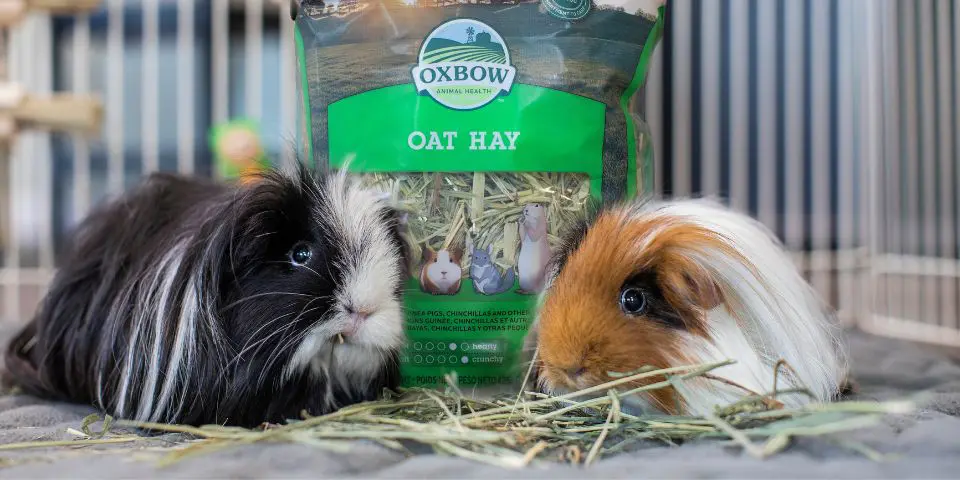
Oat Hay
While Oat Hay is not generally a hay offered to guinea pigs daily, many guinea pigs enjoy the tasty seed heads that can be found in this forage. Oat hay can be mixed in with western Timothy or orchard grass to create healthy foraging opportunities for your pet, or can be stuffed into various enrichment items such as the Treasure Barrel for additional foraging fun. If your pet is not particularly demanding, sometimes these crunchy seed heads can even be offered in lieu of a treat!
As you can see, what might be considered the “best” type of hay for guinea pigs really depends on the scenario! Our short answer: Western Timothy Hay, Orchard Grass, or Hay Blends should be the staple forage of your adult guinea pig’s diet, but don’t rule out the value of other types of hay.
